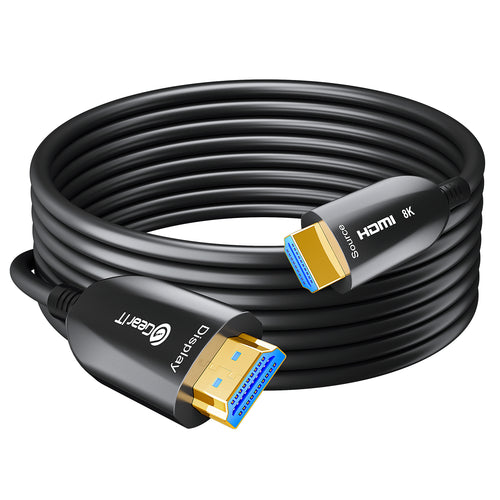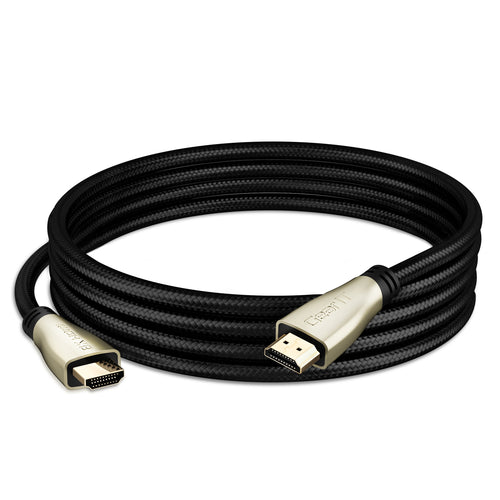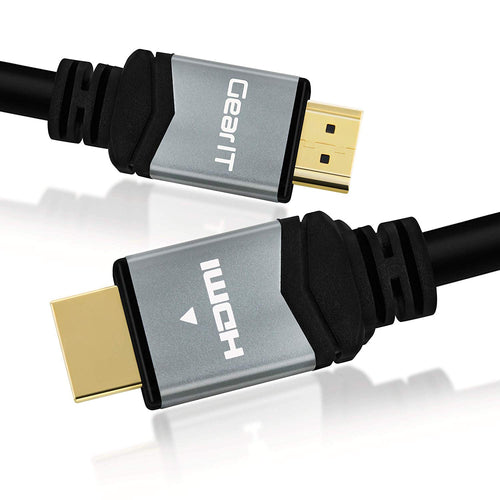
Have you ever wondered, "What is eARC?" eARC stands for Enhanced Audio Return Channel, and it plays an important role in modern home entertainment systems.
It allows high-quality audio to travel between your TV and other devices, like soundbars or AV receivers, using just one HDMI cable. This means you can enjoy a better sound experience while watching movies or playing video games without dealing with a mess of wires.
In this guide, we will explore how eARC works, its benefits, and how to set it up in your home. We’ll also help you understand why it’s becoming a must-have feature for anyone who loves great audio.
Keep reading to discover everything you need to know about eARC and how it can enhance your entertainment experience!
Understanding What is eArc and HDMI

HDMI (High-Definition Multimedia Interface) has evolved to support advanced audio formats through eARC (Enhanced Audio Return Channel). This section explores how eARC builds on the original HDMI ARC feature, its technical specifications, and the significance of bandwidth in audio transmission.
Evolution from HDMI ARC to HDMI eARC
HDMI ARC was introduced to send audio from your TV back to a soundbar or AV receiver using a single HDMI cable. It simplified connections but had limitations, such as supporting only compressed audio formats and a maximum bandwidth of 1 Mbps.
eARC improves on this by allowing for higher bandwidth and supporting uncompressed audio formats like Dolby Atmos and DTS. This means you can experience better sound quality with fewer issues. eARC also features automatic lip-sync correction, which fixes delays between audio and video.
Technical Specifications of HDMI 2.1

HDMI 2.1 is the standard that includes eARC. It supports higher bandwidth capabilities, reaching up to 48 Gbps. This increase allows for higher resolution audio formats and a broader range of features.
With eARC, transmission can handle advanced audio codecs. It supports features like lossless audio formats that provide a richer sound experience. You need compatible HDMI cables, like Ultra High Speed HDMI cables, to support these specs fully.
The Role of Bandwidth in Audio Transmission
Bandwidth plays a crucial role in how audio is transmitted between devices. HDMI ARC had limited bandwidth, which restricted audio quality. With eARC, bandwidth increases significantly, allowing for a better sound experience.
Higher bandwidth enables the transmission of uncompressed audio, which improves clarity and depth. When using eARC, your audio setup can take full advantage of formats like Dolby TrueHD or DTS-HD Master Audio. This ensures you hear all details in your favorite movies and shows.
What are eARC Functionalities and Benefits?
eARC offers several important features that enhance your audio experience. It provides support for high-quality sound, compatibility with advanced formats, and improved audio return channel capabilities.
✔️ High-Quality Audio Support
eARC supports uncompressed audio formats, allowing you to experience sound as it was intended by creators. This includes formats like Dolby Atmos and DTS. With eARC, you can enjoy multi-channel audio without any quality loss.
For the best results, use a high-speed HDMI cable with Ethernet. This ensures that all audio information is transmitted accurately and quickly. Unlike the older ARC, eARC eliminates limitations on bandwidth, making it easier to enjoy enhanced audio experiences in your home theater setup.
✔️ Compatibility with Advanced Audio Formats
One of the major benefits of eARC is its compatibility with advanced audio formats. You can play high-definition audio formats that are common in modern sound systems. eARC easily handles formats like Dolby TrueHD and DTS-HD Master Audio.
This compatibility means you can use your sound system to its full potential without worrying about audio format restrictions. It supports the latest sound technologies, which is essential for environments where high-quality sound is crucial, such as movie theaters or high-end home setups.
✔️ Improved Audio Return Channel Capabilities
eARC improves the audio return channel functions found in HDMI. This enhancement makes it easier to send audio from your TV back to the audio system. You can connect your TV and audio receiver with just one cable.
In addition, eARC resolves many connection issues seen with traditional ARC. It also supports lip-sync correction automatically, ensuring that audio matches the video you are watching. This means less time fiddling with settings and more time enjoying your media.
How Does eARC Differ from ARC?
eARC provides significant upgrades over ARC. Here are the main differences:
-
Bandwidth: eARC supports up to 37 Mbps, while ARC only handles about 1 Mbps. This increase allows eARC to transmit higher-quality audio.
-
Supported Formats: eARC works with advanced formats like Dolby Atmos and DTS, which ARC cannot fully support. This makes eARC a better choice for home theaters.
-
Audio Return Channel: eARC simplifies connecting devices. It allows for two-way communication; devices can automatically recognize each other.
-
Lip Sync Correction: eARC has built-in lip sync features that help match audio with video better than ARC. This reduces delays and enhances the overall experience.
- Device Compatibility: eARC is backward compatible with ARC. This means you can use eARC devices with ARC devices, though you won’t get eARC’s full benefits.
Benefits of eARC for Home Entertainment
eARC enhances your home entertainment experience in several ways.
1. Improved Sound Quality
eARC supports advanced audio formats like Dolby Atmos and DTS. This means you can enjoy movies and music with greater clarity and depth.
2. Easy Setup
Setting up eARC is simple. You only need one cable between your TV and audio system. This reduces clutter and makes connecting devices more manageable.
3. Compatibility with Modern Formats
eARC is designed for high-definition audio. It can handle uncompressed audio streams. This is important if you want the best sound possible from Blu-ray discs and streaming services.
4. Enhanced Device Connectivity
With eARC, you can connect multiple devices easily. This includes soundbars, receivers, and TVs. It streamlines how you manage your home theater setup.
5. Automatic Lip Sync Correction
eARC helps eliminate audio delays. You can enjoy video and audio that are perfectly in sync. This is especially noticeable in action scenes or during dialogue.
Benefits Overview
|
Benefit |
Description |
|
Improved Sound Quality |
Supports advanced audio formats |
|
Easy Setup |
Requires just one cable for connection |
|
Compatibility with Formats |
Handles high-definition, uncompressed audio |
|
Enhanced Connectivity |
Simplifies connections to multiple devices |
|
Automatic Lip Sync |
Keeps audio and video in sync |
What Devices Support eARC?

🛒 Shop 👉 GearIT 8K Premium Braided HDMI 2.1 Cable - 60Hz 48Gpbs
eARC is available in various devices designed for high-quality audio. Here are the main types of devices that support eARC:
-
TVs: Many high-end and mid-range televisions now come with eARC support. Brands like Samsung, LG, Sony, and Vizio have models featuring this technology.
-
Soundbars: Look for soundbars labeled with eARC compatibility. Popular models from Bose, Sonos, and Yamaha offer eARC, allowing for better audio quality from your TV.
-
AV Receivers: If you’re into home theater systems, several AV receivers include eARC. Brands such as Denon, Marantz, and Onkyo have models equipped with this feature.
To check if your device supports eARC, refer to the specifications or the user manual. Devices with eARC provide enhanced features, like uncompressed audio formats and improved latency.
Examples of eARC-Compatible Devices
|
Device Type |
Brands |
Models |
|
TVs |
Samsung |
QLED Series |
|
LG |
OLED Series |
|
|
Sony |
Bravia XR Series |
|
|
Soundbars |
Sonos |
Arc |
|
Bose |
Smart Soundbar 900 |
|
|
AV Receivers |
Denon |
AVR-X Series |
|
Marantz |
SR Series |
|
|
Onkyo |
TX-NR Series |
How to Set Up eARC on Your Devices?

To set up eARC, you will need HDMI 2.1 cables and devices that support eARC. Follow these steps for a smooth setup.
-
Check the Ports: Locate the HDMI ARC/eARC ports on your TV and soundbar or audio receiver.
-
Connect the HDMI Cable: Use a high-speed HDMI 2.1 cable. Plug one end into the HDMI ARC/eARC port on your TV and the other end into the corresponding port on your soundbar or receiver.
-
Adjust TV Settings: Turn on your TV and access the settings menu. Look for the “Audio” or “Sound” settings. Enable eARC or ARC to allow audio to flow from the TV to the soundbar.
-
Set Soundbar/Receiver Settings: On your soundbar or receiver, make sure eARC is enabled. This is usually found under the audio settings.
-
Test the Setup: Play some content with audio. Ensure that the sound is coming through your soundbar or receiver.
Troubleshooting Tips for eArc:
-
No Sound?: Make sure both devices are powered on and correctly connected.
-
Check Cable Quality: Use certified HDMI 2.1 cables for best performance.
- Firmware Updates: Ensure your TV and soundbar have the latest firmware updates.
Common eARC Problems and Solutions
When using eARC, you might encounter a few common issues. Here are some problems and their solutions.
1. No Audio Output
- Check Connections: Ensure all HDMI cables are securely connected.
- Compatibility: Make sure your TV and audio device support eARC.
- Settings: Go into your TV’s audio settings and enable eARC.
2. Sound Delays
- Audio Sync Settings: Look for an audio sync feature in your TV or soundbar. Adjust it to reduce delays.
- Update Firmware: Check for firmware updates on both your TV and audio device, as updates may improve performance.
3. Limited Audio Formats
- Format Support: Verify that your audio device can decode the audio format you are using. Not all devices support all formats.
- Settings Adjustment: Sometimes, changing the audio output setting on your TV can resolve this issue.
4. Intermittent Connection
- Cable Quality: Use high-speed HDMI cables rated for eARC. Poor-quality cables may lead to connection problems.
- Restart Devices: Turn off your TV and audio device, disconnect the HDMI cable, and reconnect it after a minute.
Conclusion
In conclusion, eARC, or Enhanced Audio Return Channel, is important for modern home entertainment systems because it delivers better sound quality and makes connections easier. It supports advanced audio formats like Dolby Atmos, which can greatly improve your movie and gaming experience.
If you want the best audio, think about upgrading your devices to ones that support eARC. Also, check out GearIT for high-quality HDMI 2.1 Fiber Optic Cables to get the most from your setup. Upgrade today and enjoy amazing sound in your home!
Frequently Asked Questions
Understanding eARC can help you decide if it's the right choice for your setup. Below are common questions related to eARC features, compatibility, and performance.
Is eARC better than HDMI?
eARC is a feature of HDMI 2.1 that focuses on improving audio quality. While standard HDMI can carry both audio and video, eARC allows for higher-quality audio formats like Dolby Atmos and DTS. So, if both your TV and audio device support eARC, you’ll get a better sound experience compared to regular HDMI.
Do I need eARC for my soundbar?
You don’t need eARC for your soundbar, but it can make your audio better. If your soundbar has eARC, it can deliver higher-quality sound and reduce cable clutter since you only need one HDMI cable. If your soundbar doesn’t support eARC, it will still work with regular HDMI or optical connections, but you might miss out on some features.
Is eARC better than optical?
Yes, eARC is better than optical connections. eARC can handle higher-quality audio formats, including lossless audio and surround sound like Dolby Atmos. Optical cables have limitations and can’t transmit these advanced formats. Plus, eARC uses HDMI, which means fewer cables since it can carry both audio and video.
Is eARC just for audio?
Yes, eARC is mainly for audio. It enhances how sound is transmitted from your TV to devices like soundbars. While eARC is part of the HDMI 2.1 standard, which includes video features, eARC itself focuses on improving audio quality.




































